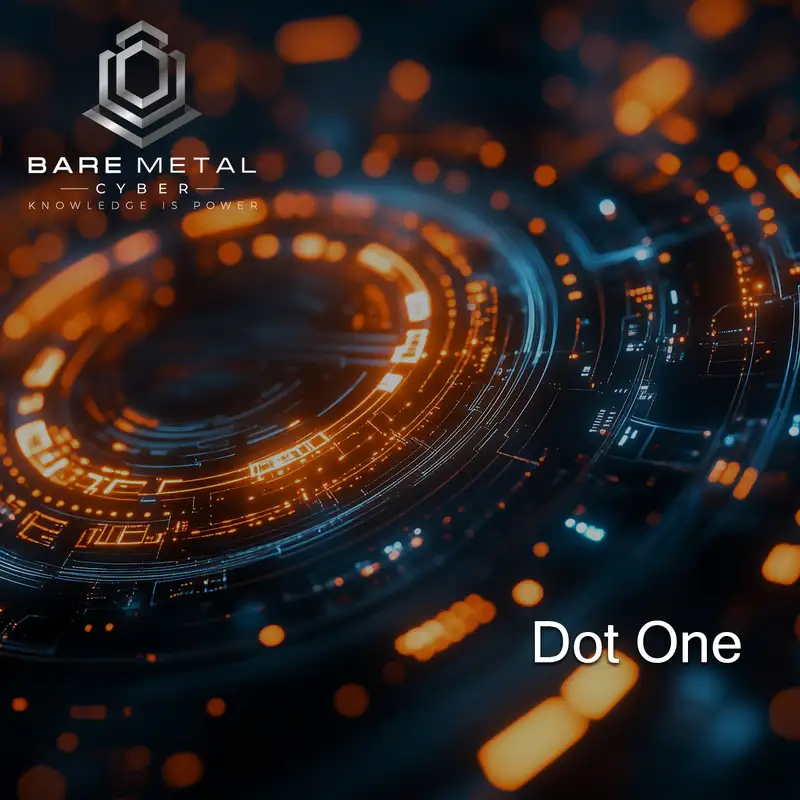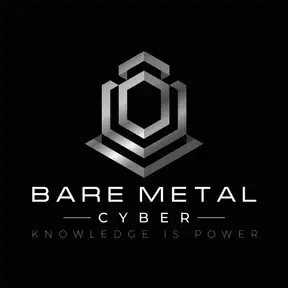Cyber Harmony: Security Orchestration, Automation, and Response
Welcome to Dot One, where we break down the key concepts of cybersecurity, making complex topics accessible and actionable. Whether you're an industry professional, a student, or just someone curious about digital security, this podcast delivers insights that help you stay informed and ahead of emerging threats. Each episode explores critical cybersecurity challenges, best practices, and the technologies shaping the digital landscape.
Be sure to check out my author profile at cyber author dot me, where you’ll find books covering cyber careers, governance, risk management, and even cybersecurity in pop culture. But for now, let’s dive in!
And today’s topic is:
Security Orchestration, Automation, and Response
Security Orchestration, Automation, and Response represents a transformative approach in cybersecurity, integrating tools, automating tasks, and coordinating responses to streamline operations and bolster defenses against an ever growing tide of cyber threats. By connecting disparate security systems, like Security Information and Event Management platforms and firewalls, it reduces manual workloads, enabling faster and more consistent threat detection and mitigation across networks, endpoints, and clouds. Its critical importance lies in enhancing efficiency, cutting response times, and minimizing analyst fatigue, all while ensuring compliance with standards like the General Data Protection Regulation in a landscape where speed and precision are paramount. As organizations face sophisticated attacks, Security Orchestration, Automation, and Response emerges as a vital ally, amplifying security effectiveness with technology driven precision.
Understanding Security Orchestration, Automation, and Response
Security Orchestration, Automation, and Response is defined as the integration of security tools and processes with automation to enhance threat detection and incident response capabilities. Its primary purpose is to streamline these efforts, making security operations faster and less error prone by reducing repetitive tasks. The focus lies on cutting manual workload for analysts, freeing them to tackle complex threats rather than routine alerts. It supports consistent and rapid security actions, ensuring responses align with policies and execute without delay across systems.
Core components drive the functionality of Security Orchestration, Automation, and Response solutions. Orchestration integrates tools and processes, linking systems like intrusion detection with ticketing for seamless workflows. Automation executes repetitive tasks, such as alert triage or log queries, with minimal human input. Response coordinates incident handling, organizing actions like containment or escalation across teams. Intelligence integration enriches context, pulling threat data to inform decisions and prioritize risks effectively.
Security Orchestration, Automation, and Response solutions come in various forms to suit organizational needs. Standalone platforms offer full functionality, providing end to end orchestration and automation features. Integrated modules embed within existing security tools, like Security Information and Event Management systems, for tighter cohesion. Cloud based solutions scale effortlessly, supporting distributed or remote operations. Open source options allow customization, letting teams tailor workflows to specific threats or budgets.
The importance of Security Orchestration, Automation, and Response to organizations underscores its operational value. Faster response to cyber incidents cuts containment time, limiting damage from breaches like ransomware. Reduced analyst fatigue and errors come from automating grunt work, keeping teams sharp for critical tasks. Enhanced scalability of security operations adapts to growing networks or threats without proportional staff increases. Compliance with regulatory response standards, such as the Payment Card Industry Data Security Standard, proves diligence through automated, logged actions.
Building a Security Orchestration, Automation, and Response Framework
Strategy development sets the foundation for a Security Orchestration, Automation, and Response framework with clear objectives. Defining goals, like reducing response times or improving detection rates, shapes its purpose and scope. Identifying key processes to orchestrate, such as incident triage or threat hunting, targets high impact areas first. Aligning with organizational security needs ensures focus on critical risks, like data breaches or insider threats. Setting metrics for success, like mean time to respond, measures progress and drives refinement.
Tool selection equips the framework with the right technology for execution. Choosing Security Orchestration, Automation, and Response platforms, like Splunk Security Orchestration, Automation, and Response, provides robust, centralized capabilities. Integrating with existing security tools, such as firewalls or endpoint protection, leverages current investments for cohesion. Evaluating scalability and compatibility ensures tools grow with networks and work with legacy systems. Assessing vendor support and updates confirms ongoing reliability and feature enhancements.
Process automation targets repetitive tasks to boost efficiency within the framework. Automating alert triage and prioritization sorts through alerts, escalating critical ones fast. Scripting repetitive response actions, like isolating infected hosts, executes them without manual steps. Streamlining threat intelligence feeds pulls data into workflows, enriching alerts automatically. Reducing manual intervention in workflows cuts delays, letting analysts focus on strategic analysis over routine chores.
Orchestration design connects systems for seamless operation across the security stack. Connecting Security Information and Event Management systems links logs and alerts into a unified view for response. Linking endpoint detection and response tools ties device security to broader actions, like quarantines. Coordinating firewall and network controls adjusts rules dynamically, blocking threats at the edge. Integrating with ticketing and reporting systems tracks incidents end to end, ensuring documentation and communication flow smoothly.
Implementing Security Orchestration, Automation, and Response
Deployment planning lays out a structured rollout for Security Orchestration, Automation, and Response success. Mapping workflows for automation targets identifies processes, like phishing response, ripe for efficiency gains. Testing integrations in sandbox environments validates connections, like Security Information and Event Management to firewalls, without risk. Rolling out in phased implementations starts small, scaling as workflows prove stable. Training staff on new processes ensures teams use automated tools effectively, adapting to changes.
Automation implementation brings efficiency to life with targeted actions. Setting up automated alert responses triggers steps, like email quarantines, for routine threats instantly. Executing predefined containment actions, such as network isolation, applies fixes without delay. Automating routine security scans runs vulnerability checks daily, catching issues early. Monitoring automation performance metrics tracks success, like reduced alert handling time, refining as needed.
Response coordination unifies incident handling with orchestrated precision. Centralizing incident response actions pulls all steps, from detection to recovery, into one platform. Automating escalation to human analysts flags complex threats, like advanced persistent threats, for expert review. Coordinating multi team response efforts aligns Information Technology, legal, and security teams seamlessly. Documenting actions for post incident review logs every move, supporting lessons learned and compliance.
Monitoring and tuning keep Security Orchestration, Automation, and Response effective over time. Tracking automated process effectiveness measures outcomes, like containment speed, against goals. Adjusting workflows for new threats updates automation, like adding ransomware signatures, as risks evolve. Reviewing false positives and negatives refines filters, cutting noise and missed threats. Enhancing automation with feedback loops incorporates analyst insights, improving precision continuously.
Challenges and Best Practices
Common challenges test Security Orchestration, Automation, and Response implementation and impact. Over automation reducing human oversight risks missing nuanced threats, like insider attacks, that machines overlook. Integration complexity with legacy systems slows deployment, clashing with old tools or protocols. Rapid threat evolution outpaces automation, as new exploits bypass static scripts. Resource demands for setup and tuning strain budgets or staff, needing expertise and time.
Best practices optimize Security Orchestration, Automation, and Response with strategic balance. Balancing automation with human judgment keeps analysts in the loop, reviewing critical decisions. Starting with simple, high impact automation targets quick wins, like alert filtering, before scaling. Regularly updating orchestration playbooks refreshes steps for threats, like phishing variants. Testing automation in simulated scenarios validates workflows, catching errors pre deployment.
Compliance and governance align Security Orchestration, Automation, and Response with legal needs. Aligning with General Data Protection Regulation response rules ensures personal data incidents meet European Union standards. Meeting Payment Card Industry Data Security Standard requirements secures payment responses, vital for finance. Adhering to National Institute of Standards and Technology guidelines leverages best practices for robust operations. Documenting automated actions for audits logs every step, proving compliance cleanly.
Future trends signal Security Orchestration, Automation, and Response’s evolution ahead. Artificial intelligence enhancing automation decisions predicts threats, like botnet growth, with smarter logic. Cloud native Security Orchestration, Automation, and Response growth scales online, fitting distributed clouds. Integration with zero trust architectures verifies every action, tightening security. Real time threat response advancements cut delays, reacting to attacks as they unfold.
Conclusion
Security Orchestration, Automation, and Response stands as a linchpin in modern cybersecurity, weaving tools and teams into an efficient, automated force that slashes response times and boosts effectiveness against relentless threats. Its impact on streamlining detection, containment, and compliance with standards like the General Data Protection Regulation transforms overburdened operations into agile defenses, reducing errors and fatigue. As threats accelerate with artificial intelligence and cloud trends, ongoing refinement ensures Security Orchestration, Automation, and Response remains a sharp, adaptive shield, securing organizations now and into the future.
Thank you for joining us on this episode of Bare Metal Cyber! If you liked what you heard, please hit that subscribe button and share it with others.
Head over to bare metal cyber dot com for more cybersecurity insights, and join the tens of thousands already subscribed to my newsletters for exclusive tips on cybersecurity, leadership, and education.
Want to be a guest on a future episode? Visit bare metal cyber dot com and fill out the form at the bottom of the page—I’d love to hear from you!
Lastly, as the author of several books and audiobooks on cyber topics, I’d be grateful for your reviews. Your support helps this community thrive.
Stay safe, stay sharp, and never forget: knowledge is power!

